Lilies come in an assortment of colors, including white, yellow, red, pink, purple, and orange. There are many choices if you’re on the hunt for orange lilies. To help narrow down the choices just a bit, here are some of our favorites.
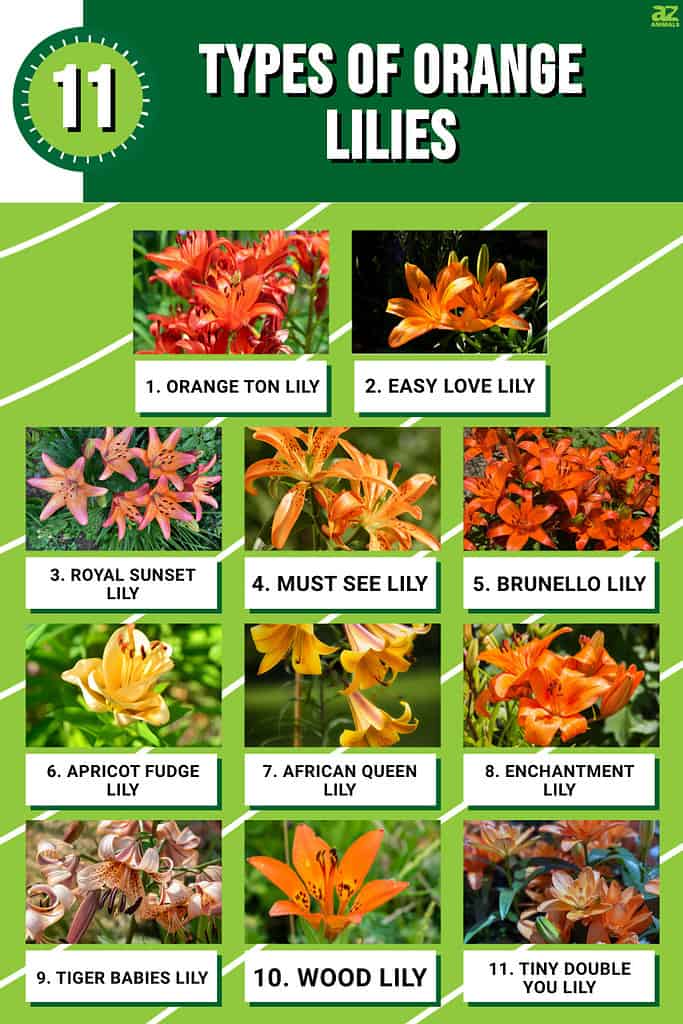
1. Orange Ton Lily (Lilium ‘Orange Ton’)
- USDA Hardiness Zones: 3-8
- Height: 3-3.5 feet
- Sun Exposure: Full, partial
If you want to make a bold orange statement in your garden, look no further. The Orange Ton lily features, well, a ton of orange!
The extra large upward-facing blooms measure up to 8 inches across. The six petals of each bloom feature orange shading that begins with a lighter, bright orange at the center and transitions to a darker pumpkin color at the edge. Unlike many lily varieties, the anthers are the same color as the petals: orange. In a discussion of orange lilies, the Orange Ton almost has to be first. This lily is all orange all the time.
The Orange Ton lily blooms early-mid summer and is easy to perennialize. In addition, it can provide bright orange colors for your garden summer after summer. And you won’t be the only one who loves these beautiful blooms. Pollinators like butterflies love them, too.
This lily is also a perfect addition to cut arrangements. It lasts a long time in a vase and, like most Asiatic lilies, the Orange Ton lily is unscented. It won’t conflict with other fragrant flowers in the arrangement.

The Orange Ton lily is all orange all the time!
©Barbara Smits/Shutterstock.com
2. Easy Love Lily (Lilium ‘Easy Love’)
- USDA Hardiness Zones: 3-8
- Height: 3-3.5 feet
- Sun Exposure: Full, partial
The Easy Love lily is just that: easy to love! Floral enthusiasts love it because of its gorgeous orange-red blooms. It can be grown in Zones 3-8, meaning gardeners from North Dakota to North Carolina can love this flower’s display in their gardens. And allergy sufferers love this plant because it is pollen-free. As the name suggests, this lily really is easy to love!
This Asiatic lily grows to around 3 feet tall and produces five to nine blooms. It is terrific as a garden plant and also in cut arrangements. This pollen-free, scent-free lily can be displayed anywhere without overwhelming your olfactories or making you sneeze. Did we mention it is easy to love?
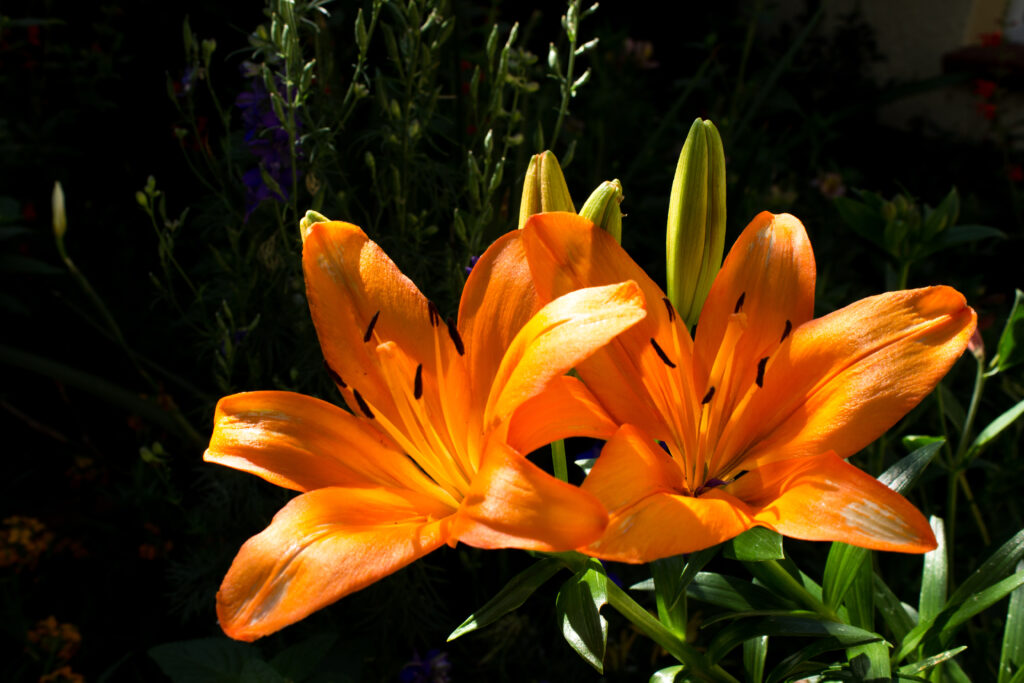
There is so much to love about the Easy Love lily.
©Marieke Peche/Shutterstock.com
3. Royal Sunset Lily (Lilium ‘Royal Sunset’)
- USDA Hardiness Zones: 4-8
- Height: 3-4 feet
- Sun Exposure: Full, partial
The lily is a hybrid of two lily divisions: Asiatic and Longiflorum (Easter) lilies. The result is a uniquely stunning lily with color speckles and blends you won’t find anywhere else.
The Royal Sunset lily features large, upward-facing blooms measuring four to six inches across with slightly reflexed petals. The colors of the six-petaled blooms include hues of burnt orange, apricot, gold, and rose. The pronounced stamens and light freckling near the center bring the whole display together.
As a bonus, the colors of the Royal Sunset lily change depending on the amount of sunlight. The flower can look quite different from overcast to sunny days.
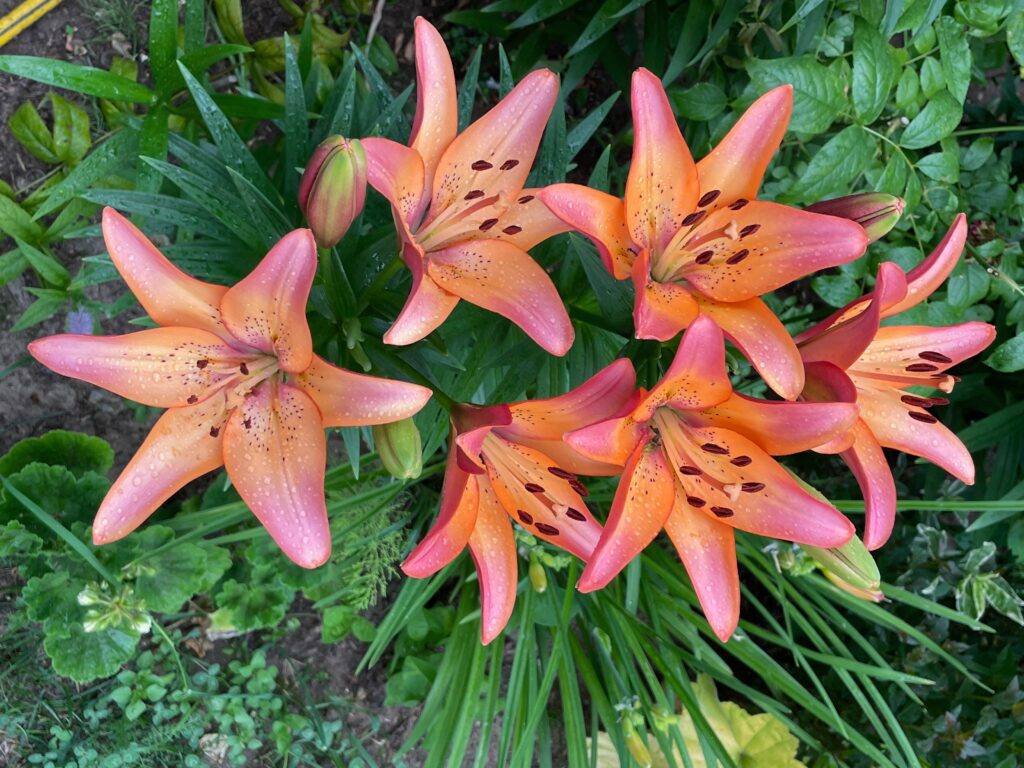
The Royal Sunset lily features hues of orange, apricot, gold, and rose.
©Galina Bolshakova 69/Shutterstock.com
4. Must See Lily (Lilium ‘Must See’)
- USDA Hardiness Zones: 4-9
- Height: 3-4 feet
- Sun Exposure: Full, partial
You’ve heard of “Must See TV.” Now meet the Must See lily. This Asiatic double lily is another pollen-free flower. Allergy sufferers rejoice! All of its blooms feature five to six-inch reflexed petals with burgundy spots. But that’s where the similarities end.
Every bloom of the Must See lily is a “must-see” because each one is different. Some are completely orange. Some have orange edges. And some are not orange at all. Must See lilies also come in cream, white, or even light green. And you’d better like surprises because you won’t know what colors you have until the blooms appear! But even after the flowers have bloomed, the surprises aren’t over. The colors may evolve throughout the growing season.
The Must-See lily is a surprise-maker and a rule-breaker! If that sounds like your personality, then you may have just met your new favorite lily.

The Must-See lily is a surprise in every bulb!
©Walter Erhardt/Shutterstock.com
5. Brunello Lily (Lilium ‘Brunello’)
- USDA Hardiness Zones: 4-8
- Height: 2-3 feet
- Sun Exposure: Full, partial
This Asiatic lily doesn’t grow as tall as some lilies on this list, only reaching 2 to 3 feet. But what it lacks in height, it makes up for in blooms. The extra large bowl-shaped blooms are 8 inches across, and there can be as many as 12 per stem.
The petals gently recurve, allowing the dark red stamens extra prominence. The vivid orange blooms contrast with the glossy green foliage. The flower is unscented and is ideal for cut arrangements. Its shorter height also makes this a great lily for container growing. Pollinators such as bees and butterflies love the Brunello lily.
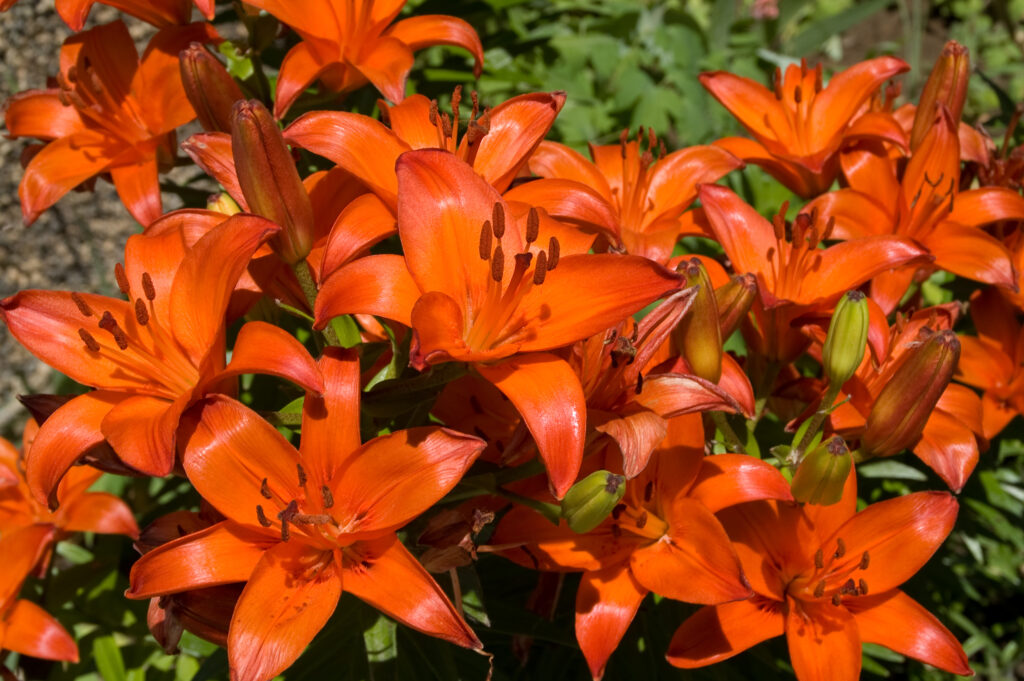
The Brunello lily’s blooms are a vibrant orange.
©Sue Smith/Shutterstock.com
6. Apricot Fudge Lily (Lilium ‘Apricot Fudge’)
- USDA Hardiness Zones: 3-8
- Height: 2-3 feet
- Sun Exposure: Full, partial
The Apricot Fudge lily is another interdivisional hybrid, crossing Longiflorum and Asiatic lilies. The result is a unique rose-shaped lily. In fact, the brown-tipped stamens might be the only tipoff that this flower is a lily at all!
This hybrid lily blooms early to mid summer. The blooms are much more compact than the extra large, showy blooms of other lilies. The Apricot Fudge lily’s blooms measure around 3 inches across. The color at the base of each petal is tangerine. It then transitions to peach as the petal grows outward.
Asiatic lilies are mostly unscented, but this hybrid lily features a strong, delightful fragrance. That fragrance is a butterfly magnet. There is just so much to enjoy about this rose-like lily.

The Apricot Fudge lily’s petals look more like that of a rose than a lily.
©Flower Studio/Shutterstock.com
7. African Queen Lily (Lilium ‘African Queen’)
- USDA Hardiness Zones: 4-8
- Height: 4-6 feet
- Sun Exposure: Full, partial
The African Queen Lily is from the Trumpet class of lilies. As such, the blooms have a signature trumpet shape and are very fragrant.
The blooms are enormous, measuring up to 8 inches long. They are so large and heavy that they droop or nod downward. The flowers feature hues of apricot/orange/gold on the inside, with a maroon-brown color on the outside. The long anthers add even more to the big, showy, almost over-the-top appearance of this lily.
The plant can grow to an impressive 6 feet tall and can feature up to 20 blossoms per stem. With such a tall plant featuring so many extra large, heavy blooms, it is a good idea to stake this lily. Otherwise, a stiff wind could snap it.
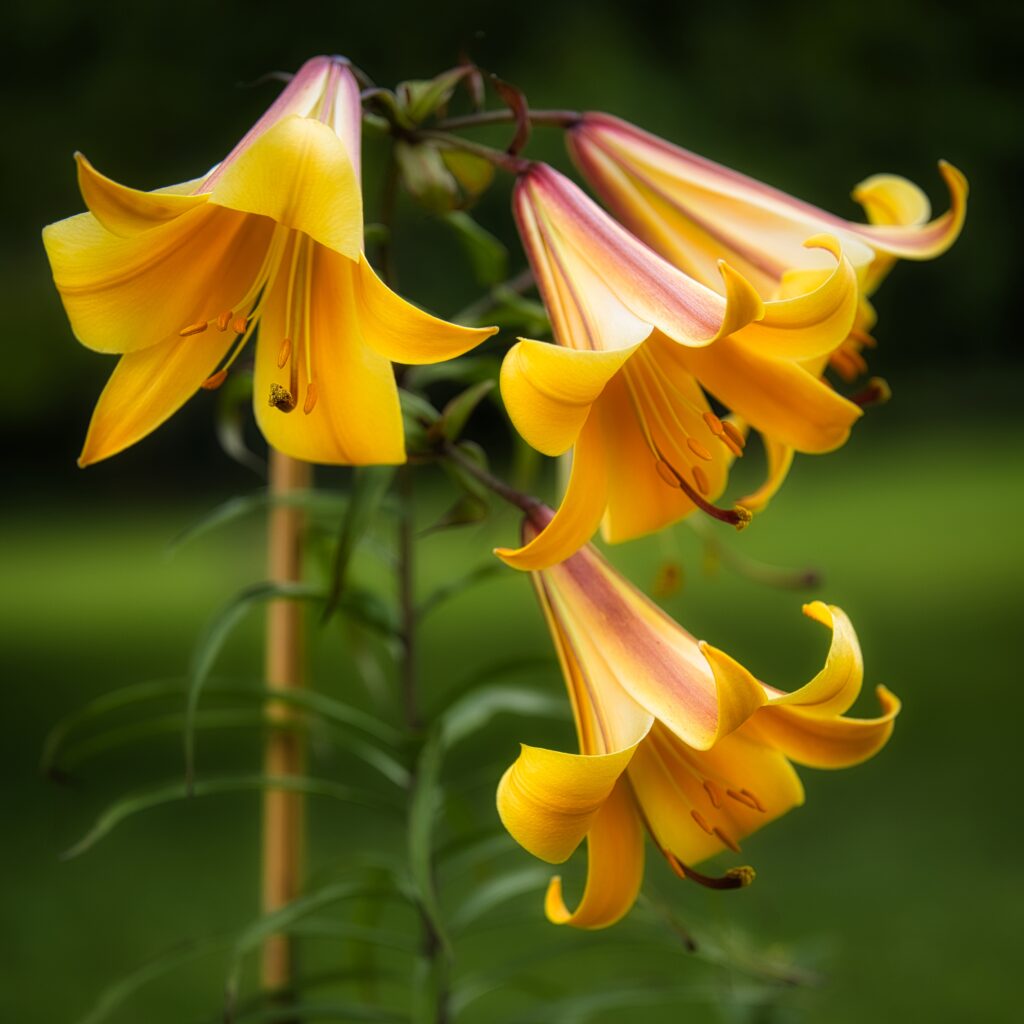
The heavy blooms of the African Queen lily gracefully nod downward.
©Wirestock Creators/Shutterstock.com
8. Enchantment Lily (Lilium ‘Enchantment’)
- USDA Hardiness Zones: 4-8
- Height: 3-4 feet
- Sun Exposure: Full, partial
Vibrant orange-red flowers with dark black/brown/red spots are the signature of the Enchantment lily. This Asiatic lily features blooms that are 4 to 6 inches wide and arrive in early summer.
The stems are rigid and strong. If you have a windy location, this is a great lily for that site.
The plant perennializes effortlessly. It also forms clumps that can be used to transplant the flower to other parts of your landscape. Who doesn’t love free flowers? That’s exactly what you get with this clump-producing cultivar.
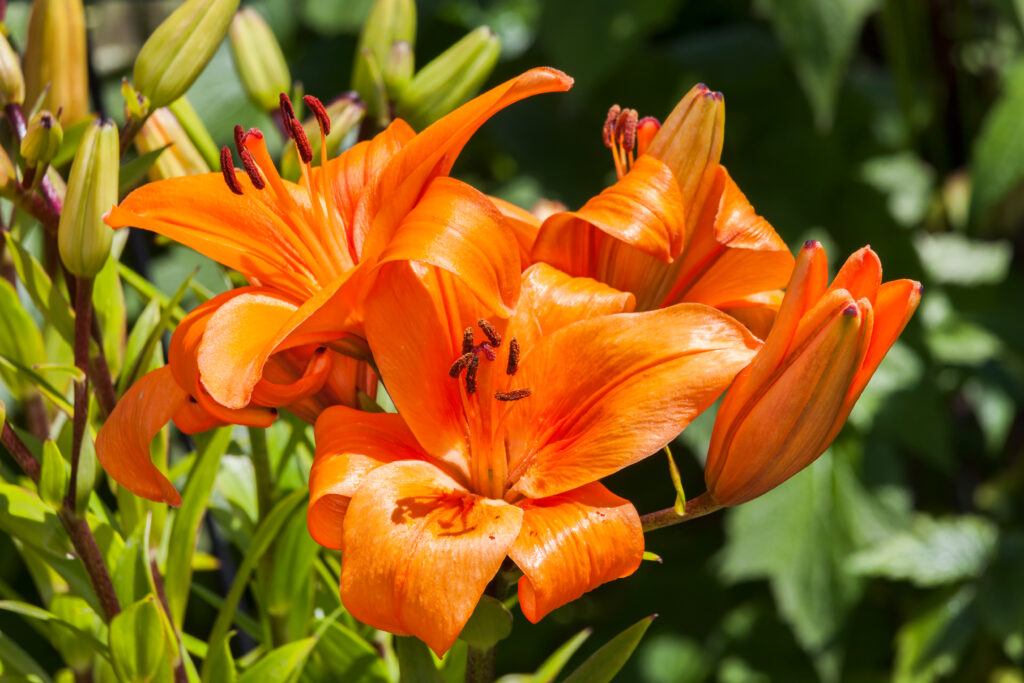
The orange-red blooms of the Enchantment lily grow up to 6 inches wide.
©Tony Baggett/Shutterstock.com
9. Tiger Babies Lily (Lilium ‘Tiger Babies’)
- USDA Hardiness Zones: 4-9
- Height: 3-4 feet
- Sun Exposure: Full, partial
The Tiger Babies lily is technically classified as an Asiatic hybrid lily, but it has the shape of a Martagon lily. The recurved petals feature a lovely shade of peach/orange with a darker raspberry/salmon throat. The plum-colored spots and the extra-long anthers just add even more to the eye-catching appeal of this showy flower.
The blooms can measure 5 inches wide and are bulky and heavy, so they will gracefully nod downward. This lily needs to be staked to prevent flopping or wind damage.
The Tiger Babies lily features a light fragrance and perennializes easily, with more robust growth in the subsequent growing seasons.
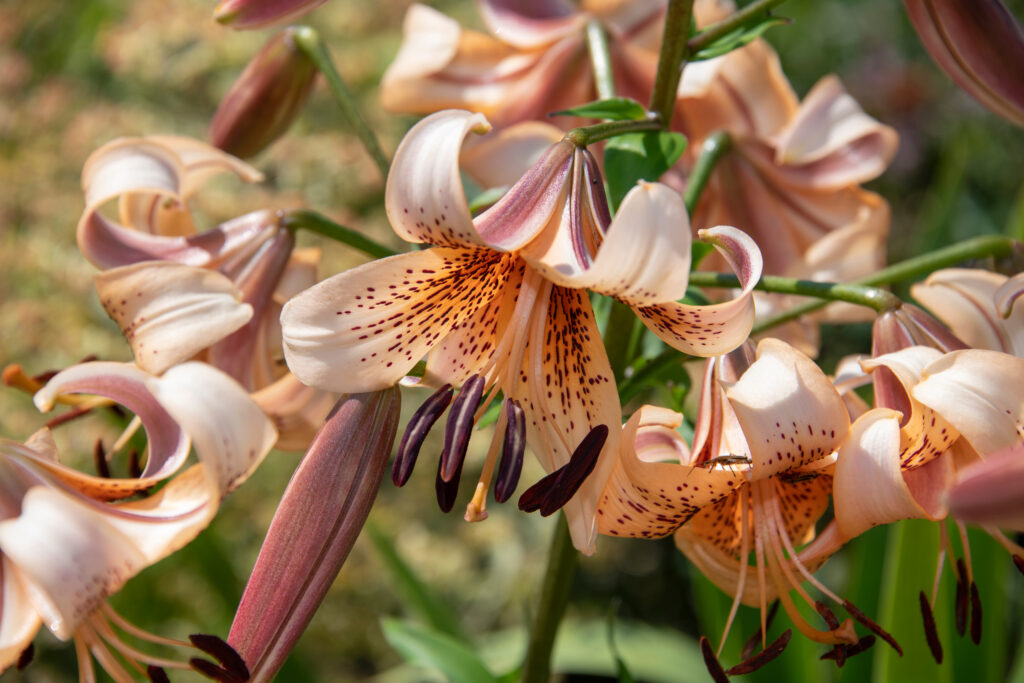
The Tiger Babies Flower is a light peach-orange lily with spots around the center of the flowers.
©Roig61/Shutterstock.com
10. Wood Lily (Lilium philadelphicum)
- USDA Hardiness Zones: 4-7
- Height: 1-3 feet
- Sun Exposure: Partial
The Wood lily is part of the group known as Species lilies. Species lilies are wildflowers native to North America, Europe, and Asia. The Wood lily is North America’s most widespread true lily, ranging from the east coast to the Midwest. It is also known as the Red lily, Northern Red lily, Prairie lily, and Philadelphia lily.
The Wood lily’s upright cup-shaped blooms are bold orange-red with a more yellow center. The petals feature maroon/purple freckles, and the anthers are extra-long. Butterflies love this lily.
The Wood lily can handle more shade than most other lilies. It is perfect for that spot that doesn’t receive quite as much sun. Since the plant is also relatively short, maxing out between 1 and 3 feet, it can be placed in smaller spaces that need a shot of bold color.
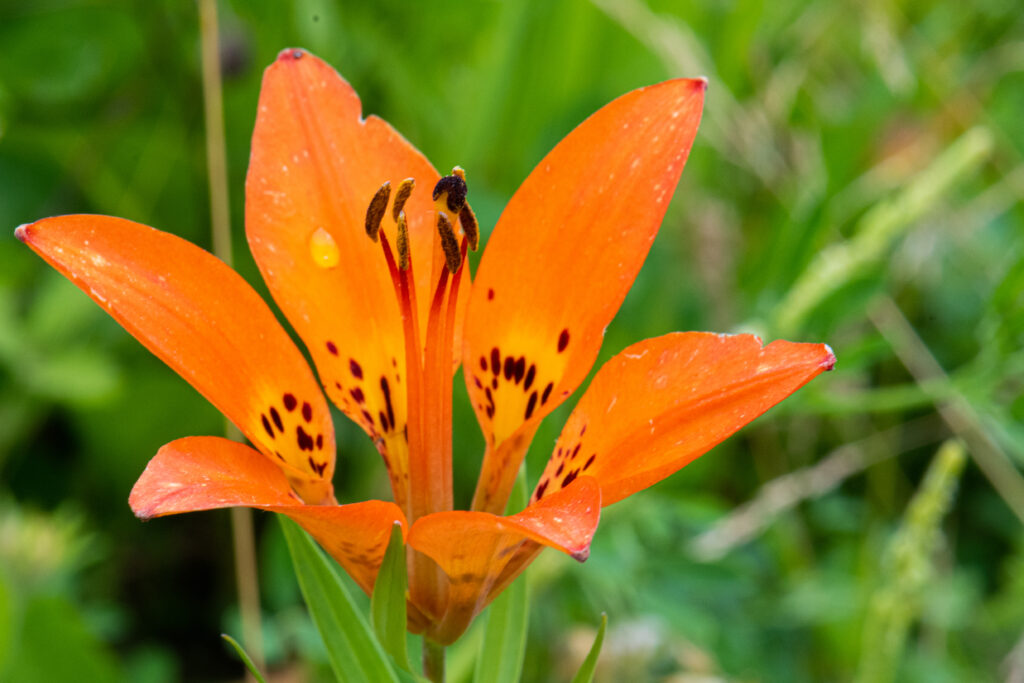
The Wood lily’s flower is an upright, cup-shaped bloom of orange, red, and yellow.
©iStock.com/Derwyn
11. Tiny Double You Lily (Lilium ‘Tiny Double You’)
- USDA Hardiness Zones: 3-8
- Height: 12-14 inches
- Sun Exposure: Full, partial
The Tiny Double You lily is an Asiatic lily that really is tiny, at least by a lily’s standards. It only grows around a foot tall. By comparison, the upward-facing blooms are rather large, measuring 4 inches across.
The short stature of this Asiatic lily makes it ideal for containers or small garden spaces. The showy fire-orange blooms are true eye-catchers.
Unlike many lilies, deer tend to shy away from this one. If you are a gardener in a deer-prone area, you know that’s a big deal! But, while deer don’t like this flower, butterflies and hummingbirds love it.
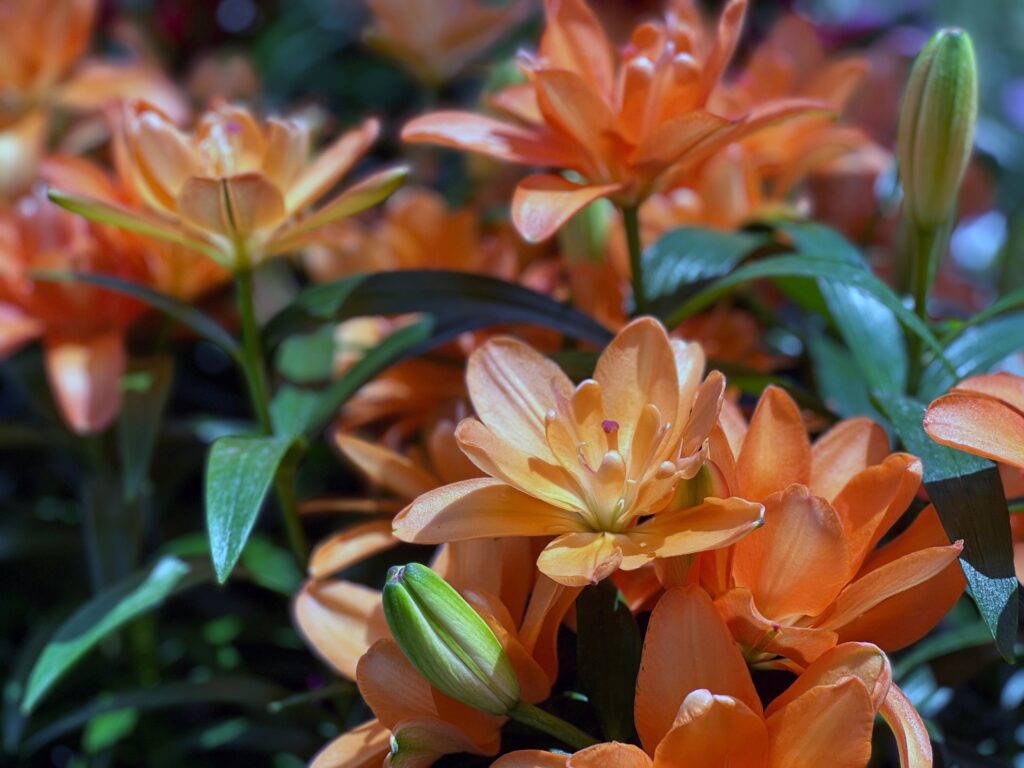
The Tiny Double You lily only grows to around a foot tall.
©Joanne Dale/Shutterstock.com
Growing Lilies
Planting and Watering
Choose a sunny site for your lilies. At least six hours of sun per day is recommended. Lily bulbs can be planted in either the spring or the fall.
Plant the bulbs in a 6-inch hole, ensuring that the roots are facing downward. When you plant a display of multiple lilies, separate the holes by roughly three times the width of the bulbs. Toss in some bone meal when planting the bulbs. This will provide nutrients throughout the first growing season.
Water the bulb generously after planting and also wanter consistently throughout the growing season. While you don’t want to waterlog your lily plants, you certainly don’t want the soil to dry out. Lilies need consistent moisture.
During the growing season, deadheading will help your lilies reach their full potential. By removing the spent blooms, all the plant’s nutrients and energy will funnel into the healthy, growing blooms.

Plant lily bulbs in 6-inch holes ensuring all roots face downward.
©Damian Lugowski/Shutterstock.com
Common Lily Pests
Lilies can be susceptible to a variety of pests. Aphids lead the way as the most common, and potentially most destructive, lily pests. Aphids reproduce quickly, and an infestation can get out of hand seemingly in the blink of an eye. An aphid infestation can easily destroy a lily plant.

Aphids may be the most common lily pest.
©schankz/Shutterstock.com
An environmentally-friendly solution like diluted neem oil can be effective at ridding the plant of these pests. It’s safe for you, the plant, and all the other plants surrounding it.
Insecticidal soap is a popular aphid treatment for many plants, but some lilies may not tolerate the treatment well. Check your specific lily to see if it can handle it. If so, insecticidal soap is another environmentally-friendly and highly effective aphid treatment.
Aphids aren’t the only pests that love lilies, though. The plants also attract lily beetles, slugs, lily thrips, and lily weevils.
If organic treatments are ineffective, you may need a synthetic pesticide to rid your lilies of these pests. This is especially true if the infestation has already grown large. You need to act fast, or your lilies will be destroyed. These pests won’t stop until the plant is dead. If you do use chemicals, follow all the label instructions carefully.
Gray mold, or botrytis blight, is a common disease among lilies. Unfortunately, there is no cure. There are only preventative measures, such as fungicide treatments. Use these treatments to keep your lilies healthy. If gray mold has already appeared, there is little that can be done to save the plant. Uproot it to keep the disease from spreading to other lilies nearby.
Rabbits and deer love to treat your lilies like their own personal salad bar. The damage is noticeable but often not fatal. Use a commercial repellent to try to keep these cute but rather destructive woodland creatures away.
Toxicity
It’s very important to note that lilies, including the ones listed above, are highly toxic, even lethal, to cats. Dogs are normally perfectly safe around most lilies, but you may want to keep them away just as an extra precaution. But if you have cats, there is no question about the danger.
Lilies can cause Acute Kidney Injury (AKI) in cats. Signs of AKI include anorexia and vomiting. Some lilies are so toxic to cats that even the pollen from the plant can cause AKI. Keep those kitties far away from your lilies!

Lillies are highly toxic to cats. Keep your kitty away!
©iStock.com/Pijarn Jangsawang
Summary of 11 Types of Orange Lilies
Here’s a recap of the 11 lily types with orange colorations that we took a look at.
| Number | Lily | USDA Hardiness Zones | Height |
|---|---|---|---|
| 1 | Orange Ton Lily | 3-8 | 3-3.5 feet |
| 2 | Easy Love Lily | 3-8 | 3-3.5 feet |
| 3 | Royal Sunset Lily | 4-8 | 3-4 feet |
| 4 | Must See Lily | 4-9 | 3-4 feet |
| 5 | Brunello Lily | 4-8 | 2-3 feet |
| 6 | Apricot Fudge Lily | 3-8 | 2-3 feet |
| 7 | African Queen Lily | 4-8 | 4-6 feet |
| 8 | Enchantment Lily | 4-8 | 3-4 feet |
| 9 | Tiger Babies Lily | 4-9 | 3-4 feet |
| 10 | Wood Lily | 4-7 | 1-3 feet |
| 11 | Tiny Double You Lily | 3-8 | 12-14 inches |
The photo featured at the top of this post is © Barbara Smits/Shutterstock.com
Thank you for reading! Have some feedback for us? Contact the AZ Animals editorial team.






